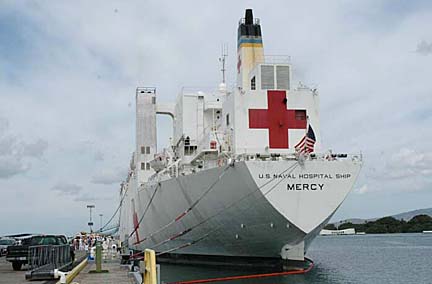
|
Hospital ship ready
for distant disasters
Local officials weigh the value
of the vessel in an isle emergency
A hospital ship with 1,000 beds and 12 operating rooms "isn't the usual disaster tool" but it could serve Hawaii during a severe hurricane, earthquake or tsunami, says a University of Hawaii professor of public health.
Frederick Burkle was among Hawaii disaster management and health officials touring the USNS Mercy before the Navy hospital ship left Wednesday for San Diego.
The ship is returning to its home port after helping thousands of earthquake and tsunami victims in Banda Aceh and Nias, Indonesia, East Timor and Papua New Guinea since February.
Burkle, a retired navy captain and doctor, said he served on the Mercy in a reserve capacity a number of years ago. He headed an evaluation team on the ship for two weeks from Hawaii to California.
He also commanded a trauma center during the Persian Gulf War and referred patients to the Mercy when it was sent there to provide medical services.
He retired in 2000 as chairman of the Division of Emergency Medicine at the John A. Burns School of Medicine and has returned as a full professor, teaching disaster management.
The Indonesia mission was the first for the Mercy since Desert Storm and Desert Shield in 1991 and the first time a hospital ship of its size has been used after a major disaster, Burkle said.
He said use of a hospital ship from a government in disasters is debated because it is expensive. "Our disaster tools are improving every day. Whether this will end up being one such tool, we'll have to see."
Indonesia's tsunami occurred Dec. 26 and the Mercy couldn't get there until February. "But it appears that they did a great good in the area that is often not considered in routine disaster management," Burkle said.
"Because so many health care providers died directly because of the wave, and because so many facilities were destroyed, there was still a need for hospitals."
The Mercy served as a referral hospital to take more complex cases from other hospitals, he said.
On the ship Tuesday, representatives of the state and Oahu civil defense agencies, the Blood Bank of Hawaii, American Red Cross, Healthcare Association of Hawaii, U.S. Centers for Disease Control and Prevention and other organizations discussed possible use of the Mercy in a Hawaii disaster.
If hospitals here were destroyed, the ship wouldn't be that far away and probably could serve as a major hospital for Hawaii for some time, Burkle said.
John Cummings, Oahu Civil Defense spokesman, said the Mercy "would be an excellent resource in time of need."
He said the group discussed what would happen if a major hurricane hit Oahu. "The ship itself and equipment it could bring to Hawaii to support us would be an incredible opportunity."
Capt. Mark Llewellyn, commanding officer of the Mercy, said, "It is truly a national asset. It is also a national treasure."
A similar Navy hospital ship, the Comfort, serves the Atlantic from the East Coast.
"Both ships stay at the ready to proceed within five days," Llewellyn said. A team of civilian mariners and Navy duty personnel stay on the ship at all times to maintain the readiness position.
Combat support is the primary mission of the ships and, secondly, humanitarian assistance and disaster relief, Llewellyn said, pointing out they must be deployed by the president or secretary of defense.
In the discussions on the ship, Burkle said he emphasized the importance of government restoring essential services in time of disaster.
"There were some assets (on the Mercy) that will probably be useful in the future that were not necessarily used," he pointed out.
The hospital ships can generate tremendous electricity, produce volumes of water and serve as public health laboratories if others are destroyed, he said.
If the Mercy came here after a disaster, it could be used for shelter if buildings were destroyed and it could generate clean water and electricity and provide other essential services, he said.
E-mail to City Desk
[News] [Business] [Features] [Sports] [Editorial] [Do It Electric!]
[Classified Ads] [Search] [Subscribe] [Info] [Letter to Editor]
[Feedback]
